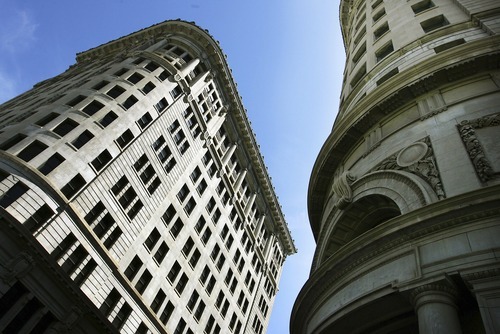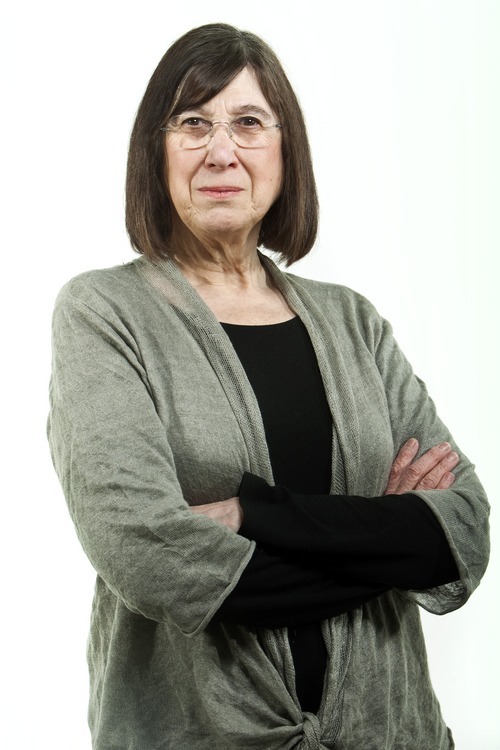This is an archived article that was published on sltrib.com in 2012, and information in the article may be outdated. It is provided only for personal research purposes and may not be reprinted.
When you look up at the Boston and Newhouse buildings on Exchange Place just off Main Street between 300 and 400 South, there's more than meets the eye.
These Beaux-Arts twin structures are considered Utah's first skyscrapers and were financed by one of the state's wealthiest mining magnates, Samuel Newhouse. Their presence represented the historical polarization between the north-end (Mormon) and south-end (non-Mormon) businesses that formed separate commercial districts within downtown Salt Lake City — and Newhouse's determination to create a "Wall Street" in the West.
Newhouse, the son of Russian-Jewish immigrants, left an unsuccessful law practice in Pennsylvania and went westward in the early 1880s in search of opportunity. He landed in Leadville, Colo., met and married 16-year-old Ida Stingley and purchased a hotel. When Ida nursed an ailing English guest back to health, the grateful gentleman became Samuel's friend and financial backer.
Newhouse was a flamboyant promoter and speculator. He developed contacts on the East Coast and in England and France. He hired a tutor to educate his wife in the manner of European high society. After acquiring numerous mines in Ouray, Colo. — and selling them later for millions — the couple moved to Denver to further his entrepreneurial leanings.
By 1896, he had turned his attention to Utah.
From the Highland Boy mine in Bingham Canyon to the copper smelter in Murray, Newhouse's acquisitions and partnerships grew into multimillion-dollar investments. In 1905, he bought the Cactus Silver Mine and mill in the San Francisco Mountains of Beaver Canyon.
He then spent more than $2 million to rebuild a nearby mining town called Newhouse, replete with cottages, homes, boardinghouses, stores, restaurants, a hospital, school, park, livery, hotel, dance hall and Cactus Club.
Newhouse hobnobbed with British royalty. He was involved in the creation of New York City's first steel-frame skyscraper, the Flatiron Building, and gained and lost mineral rights in China.
He owned Long Island and London estates, a chateau in France and an extravagant home on South Temple flush with opulent Persian carpets, Italian marble floors, velvet upholsteries, copper railings, stained-glass windows, silk tapestries and an underground men's sitting room stocked with 1,400 bottles of wine and imported liquors.
In 1906, Newhouse hired well-known Chicago/New York architect Henry Ives Cobb (a relative of outspoken Utah suffragist Charlotte Cobb Ives Godbe) and in 1907 began construction of the Boston and Newhouse buildings.
Each stone-faced, fireproof building was steel-framed with rounded corners, 11 stories that were divided into three horizontal sections emphasizing the "main floors, vertical office floors and a massive cornice which imitates the base, shaft and capital of a classical column."
Distinctive though similar in style, a band of cartouches (coat-of-arms shields) spread beneath the second-story cornice of the Boston building and was replicated below the building's cornice along the top. Other ornamentation included elaborate lion head stonework.
The Newhouse building gleamed with a copper-plated door and window trim. Stone pairs of cornucopias, agricultural and industrial symbols, and an enormous buffalo headstone were fixed in place. The interiors were drenched in fine woodwork, terrazzo floors, marble stairs, floor-to-ceiling handcrafted mosaic tiles and extensive glass.
Newhouse developed 30 other properties, including the Newhouse Hotel. He donated Exchange Place land for the sumptuous Commercial Club building and the Salt Lake Stock Exchange where Utah's stockholders, bankers and mining kings held business, traded and negotiated.
His plans were to build up the south-end commercial district. But shortly before World War I, Newhouse's financial fortunes unraveled. Unable to obtain domestic or foreign loans, he went bankrupt.
In 1914, the Newhouses' marriage also dissolved. Ida, who spent much time in Europe, eventually moved to the Beverly Hills Hotel in California. Relying on the charity of friends, she died penniless in 1937.
Newhouse lived with his sister in their French chateau. He continued in the world of finance but could not recoup his staggering losses. He died in 1930, his legacy to Utah standing tall.
Eileen Hallet Stone may be reached at ehswriter@aol.com. Sources: A Homeland in the West: Utah Jews Remember, city walking tours and saltlakearchitecture.blogspot.com.





